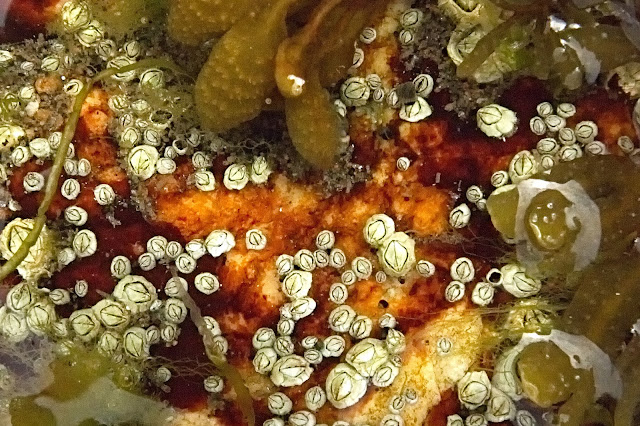Fox Island has been around for millions of years. Thus, its surface has weathered due to water (in the form of ice, rain, and waves), wind, and organism activity.
The black, slippery cyanobacteria (Calothrix spp) covers the rock in the supralittoral zone (or splash zone). This most ancient organism is "coated with a slime that prevents them from getting dehydrated at low tide; this also makes the rocks slippery for tide pool-exploring humans." "This black stain marks the limit of high tide, as Calothrix can only tolerate salt water occasionally." Schmitt, Catherine. A Coastal Companion: A Year in the Gulf of Maine, From Cape Cod to Canada. Gardiner, Maine: Tilbury House Publishers, 2008. Print.
This weathering has produced depressions that form tide pools; places where water sits until high tide occurs again. Up in this area, water just splashes up from wave action.
The pools range from tiny, shallow puddles, to broad shallow depressions, to deep holes.
Drew found one of these deeper holes that was about 12-18 inches deep. He tried using the Apeman motion camera underwater, but his attempt did not work this time. We have to keep practicing to really understand how close we can get to an object to still have it in focus. We are shooting blind, so to speak. And, it was so bright out that we couldn't look at the video that we had already taken. That just means that we're going to have to visit the beach again;-)
First I checked out this tide pool, but I wasn't satisfied with it. So, I moved further down into the slick, cyanobacteria covered section.
Because of the cyanobacteria coated rocks, it was super slippery and I couldn't get any traction with my hiking boots. So much so, that I had to inch my way to this tide pool whilst sliding along on my butt!
I hung out at this shallower tide pool and took shots from the top of the pool. Unfortunately, I had forgotten to bring the polarizing filter (gee, we never bring quite everything we need;-), but was able to shade the surface sufficiently to capture some images. I believe the green algae is Ulva intestinalis aka Enteromorpha intestinalis? If so, this algae lives in many different habitats and takes on many different forms.
And, in these tide pools, various organisms, who can handle harsh conditions, thrive. I am not sure what the yellow, jelly-like looking organism is, that is covering the rocks. First I thought it might be related to some kind of encrusting tunicates? Could the red, jelly-like organism be Hildebrandia spp (red crust algae?) I need to take a tide pooling course from a marine biologist. I have found a good resource blog titled, Between the tides of Nova Scotia. It has lots of photos of marine life. Another fabulous website resource is Rocky Intertidal Habitats Along The Coast of Maine, by Robert Zottoli, Professor Emeritus, Fitchburg University.
And, lastly this part of the pool with some brown algae, Fucus filliformis, fronds (I believe.)









No comments:
Post a Comment